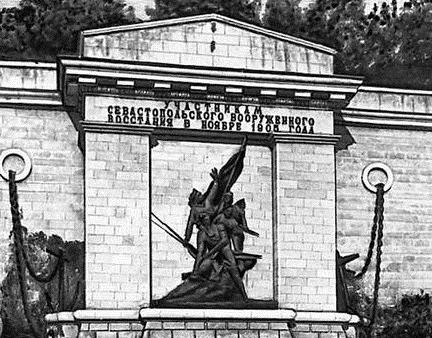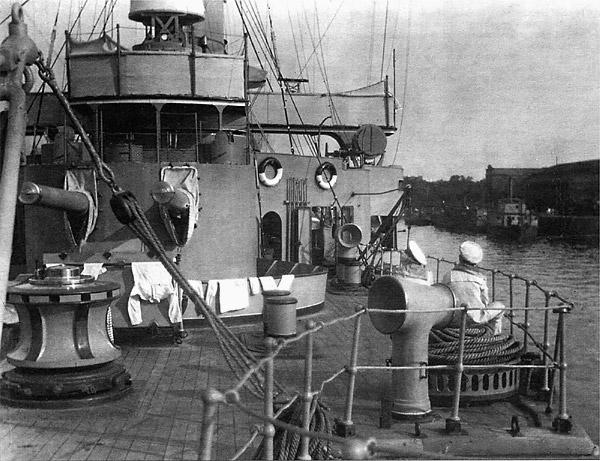Today it is difficult to imagine how immensely famous in the first Soviet decades the image of the legendary lieutenant of the Russian fleet P.P. Schmidt. Everyone knew his biography, Soviet children wanted to be like the legendary revolutionary, and the uprising of the crew of the cruiser "Ochakov" was perceived as a glorious page of revolutionary history and a portent of the triumph of popular power.
Why the rebel lieutenant was forgotten
In the era of mature socialism, the rebel officer who led the sailor riot, too, did not seem to be forgotten, but rarely recalled. Especially after another “revolutionary”, Captain of the third rank Sablin, nearly took the Soviet large anti-submarine ship Watchdog to Sweden (1975), putting forward political demands to the leadership of the USSR. The similarity of the circumstances of the two rebellions, separated in time by a seventy-year interval, in a certain sense cast a shadow on Lieutenant Schmidt. The events at the Potemkin got great fame.
Two similar rebellions
In the memory of schoolchildren of the late socialist era, two episodes that occurred in the Russian fleet at the very height of the Russo-Japanese war were mixed. On the battleship “Prince Potemkin of Tauride”, the discontent of the sailors with bad food resulted in a riot, accompanied by violence and casualties. The officers were drowned at sea and put to death by all means, then artillery shots began at Odessa. The ship went to Romania, where it was interned, and the team disbanded.

Something similar happened in Sevastopol, and not only on the Ochakovo, but also on other ships of the Black Sea Fleet. The difference was that of all the rebels in the Odessa raid, only sailor Vakulenchuk, who was killed by an officer while trying to suppress a riot, went down in history. The uprising on the cruiser "Ochakov" was led by an officer, a representative of the naval elite of tsarist Russia. He was remembered for spectacular and laconic signal messages and a telegram to the emperor. And the number of victims this time was much greater.
Historical background
Russia is a huge country. On its territory, neighboring states have always flirted, wanting to grab at least a little in their favor. The Far Eastern threat came from Japan. In 1904, intentions to expand territorial possessions grew into full-scale hostilities. Russia was preparing for this, but the country's leadership did not rearm quickly enough. Nevertheless, powerful cruisers of recent projects were launched into the water for several years.
A series of ships of rank I included the Bogatyr, Oleg, and Cahul. The last armored cruiser of this project was the Ochakov. These ships were high-speed, had powerful artillery weapons and met all the requirements of naval science of that time. The crew of each of them was approximately 565 sailors. Cruisers were supposed to defend the coast of the Fatherland in different seas that washed the empire.
War with japan
The war with Japan was extremely unsuccessful. There were several reasons for this - from poor preparedness of the troops to simple bad luck, expressed in the accidental death of Admiral Makarov in the Port Arthur raid. There was an activity of Japanese intelligence, which manifested itself in a comprehensive undermining of the defense power of Russia and inciting sentiment of discontent. Of course, it cannot be argued that the foreign intelligence service organized an uprising on the cruiser Ochakov. The date of November 13 marked the day when officers left the ship, prompted by the disobedience of the team and the fear of being killed. Without an analysis of previous events, it is impossible to understand the circumstances of the riot.
How it all started
And it all started back in October, during the All-Russian political strike. Of course, Japanese intelligence is related to the organization of this political action, although it is not decisive. Unrest took place, including in the Crimea. Railroad workers, workers of printing houses, banks and many other enterprises went on strike. The Tsar’s manifesto of October 17 did not cool the fervor of the fighters for civil liberties; on the contrary, they perceived this document as a manifestation of weakness. Lieutenant Schmidt spoke at the rally. During the dispersal of the demonstration, eight people were killed, the lieutenant himself was arrested among other instigators of the riots, but already on October 19, Schmidt was present at the meeting of the City Duma as a delegate from the people. At this point, power in Sevastopol almost passed to the rebels, the order was controlled by the people's police, and not the legitimate police. Later, Schmidt will speak at the funeral of victims of the dispersal of the demonstration and make a fiery speech. He was immediately arrested again and until November 14 was kept on the battleship “Three Saints” under the pretext of official embezzlement. It was released when the uprising on the cruiser "Ochakov" and several other ships of the Black Sea Fleet had already occurred.
What was Schmidt
Pyotr Petrovich Schmidt lived only 38 years, but his fate was so generously filled with various events that it would take a whole book, possibly more than one, to describe it. The rebellious lieutenant had a complex character, and his actions could be called contradictory if a certain logic were not guessed in them. From childhood, Peter suffered from a mental illness that did not leave him all his life - kleptomania. She appeared even in childhood, in the junior preparatory class of the Naval College, when the boy began to steal small things from fellow practitioners. After graduation, everyone who knew the young man noted his extremely nasty character and increased irritability caused by hypertrophic pride. While serving in the Navy, he somehow managed to marry a prostitute Dominika Pavlova, whom he met with Mikhail Stavraki (by the way, it was he who in 1906 would command the execution of Schmidt). Only the descent from a glorious naval family saved the young man from expulsion from the fleet more than once or twice.

For all his shortcomings, the officer was distinguished by excellent abilities for exact sciences, had a good command of navigation and other marine wisdom, and loved to play the cello. After gaining an officer rank, midshipman Peter Schmidt received a vacation - during this period he worked at an agricultural equipment factory. In the future, this gave him reason to consider himself a person who knows the life of an ordinary people. When the opportunity arose to become famous, he led an uprising on the cruiser Ochakov - 1905 became his star time.
Banner of the rebels
Official Soviet historical science argued that the events of 1905 had a serious political and economic base, but if not for one decisive officer, then they might not have been, at least in Sevastopol. In fact, the uprising on the cruiser “Ochakov” was not prepared and carried out by Schmidt at all, but by the strike group, which consisted of the underground Bolsheviks N. G. Antonenko, S. P. Chastnik and A. I. Gladkov. Obviously, they needed someone enjoying a certain authority and wearing naval epaulets. The eloquent officer was noticed, most likely, in the days preceding the riot. So Schmidt became a living "banner." He obviously liked this role.
How Schmidt commanded the fleet
The uprising on the cruiser “Ochakov” took place on November 13, and already on November 14, a lieutenant freed from the dungeons, already wearing shoulder straps of the captain of the second rank, arrived on the ship. There is an explanation for this: in accordance with the current Table of Ranks, the next rank after the lieutenant was precisely this rank, and upon resignation it was assigned automatically. However, the fact that the fighter with the autocracy is so reverent about the ranks and ranks speaks volumes. An officer who arrived on the ship immediately ordered that he seize his assumption of the post of commander of the entire fleet, and also give the emperor a telegram in which he demanded political reforms. In addition, he visited several military units and successfully persuaded the crews to support the rebels.
Grigoryev's version
There was nothing surprising in the fact that the naval command immediately ordered the immediate and merciless suppression of the rebellion. But these events have one more background, which allows them to be perceived differently. The famous historian Anatoly Grigoriev wrote about a series of articles about the uprising at Ochakovo, from which it becomes clear what was unusual at that time for tough actions. The fact is that heavy fire was opened almost immediately after the rebel ships, which continued even after the combat mission was practically completed and the resistance was suppressed. In addition, the cruiser could not give a full rebuff, since work on it had not yet been completed - it was in the process of completion and did not have weapons, of which, of course, everyone knew.

The version is as follows: unlike the Bogatyr series ships launched earlier, the Russian cruiser Ochakov was built with numerous violations of technology, and the construction process was accompanied by abuses of powers expressed in the usual embezzlement. Those involved in this criminal scam sought to hide their tracks. When the uprising began on the cruiser "Ochakov", they took him as a happy chance to get rid of the evidence that this ill-fated ship was. The result was many casualties and severe damage to the ship. It was not possible to sink him - even when they stole, under the king they built on conscience.
Summary
Today, it is highly likely to imagine how it was. The uprising on the cruiser Ochakov, like many other cases of mass disobedience in the army and navy, was the result of the subversive work of the Social Democratic Party, which sought to weaken Tsarist Russia in every way, even at the cost of military defeats. Problems in the armed forces, of course, were. Moreover, they are and always will be in any country. If insufficient food quality causes a riot (and the satisfaction of sailors as a whole has always been very good, even by today's standards), then the country's leadership should have thought hard and taken urgent and tough measures to prevent such incidents from happening on. Despite the death sentences imposed on the instigators (Schmidt, Gladkov, Antonenko and Chastnik were shot on Berezani), no serious conclusions were drawn. Many other tragic events took place, called the first Russian revolution, part of which was the uprising on the cruiser Ochakov. The date "1905" was then forever painted in blood red.